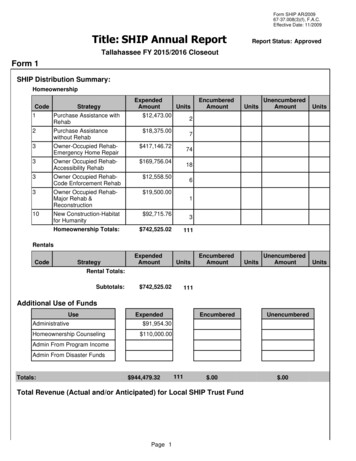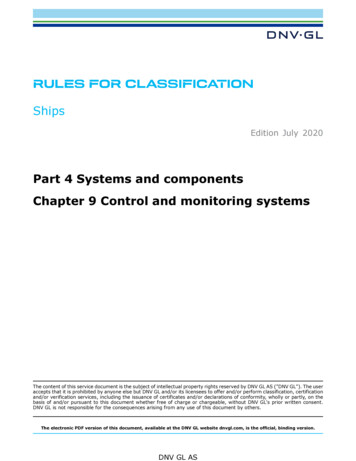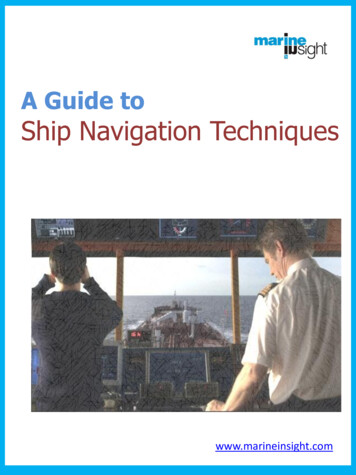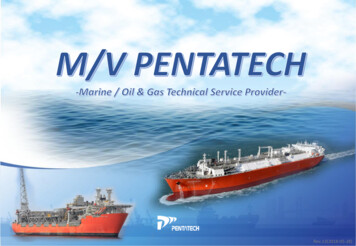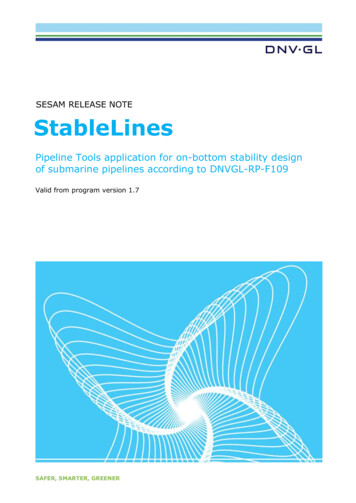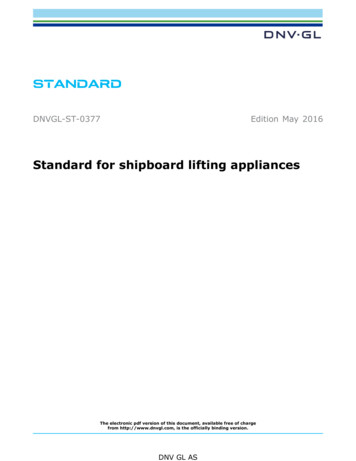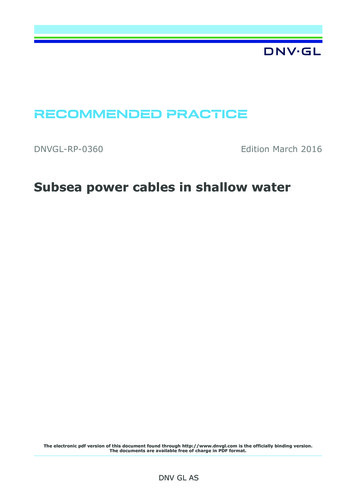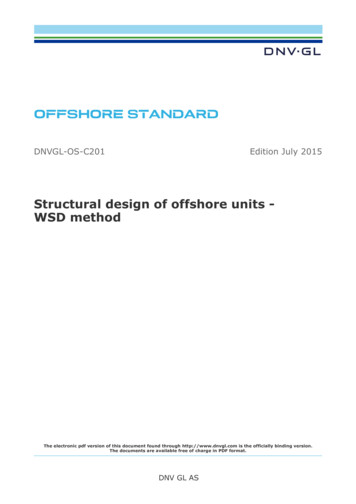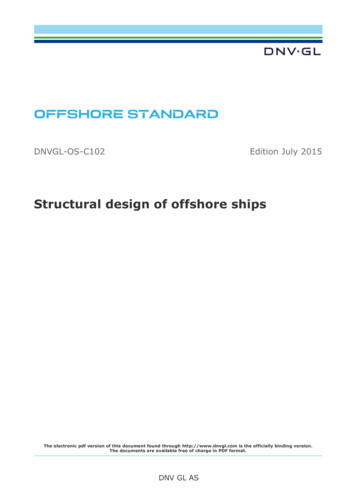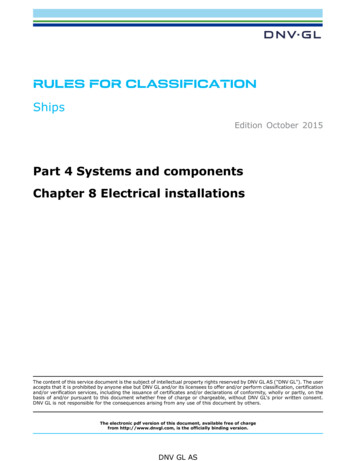
Transcription
RULES FOR CLASSIFICATIONShipsEdition October 2015Part 4 Systems and componentsChapter 8 Electrical installationsThe content of this service document is the subject of intellectual property rights reserved by DNV GL AS ("DNV GL"). The useraccepts that it is prohibited by anyone else but DNV GL and/or its licensees to offer and/or perform classification, certificationand/or verification services, including the issuance of certificates and/or declarations of conformity, wholly or partly, on thebasis of and/or pursuant to this document whether free of charge or chargeable, without DNV GL's prior written consent.DNV GL is not responsible for the consequences arising from any use of this document by others.The electronic pdf version of this document, available free of chargefrom http://www.dnvgl.com, is the officially binding version.DNV GL AS
FOREWORDDNV GL rules for classification contain procedural and technical requirements related to obtainingand retaining a class certificate. The rules represent all requirements adopted by the Society asbasis for classification. DNV GL AS October 2015Any comments may be sent by e-mail to rules@dnvgl.comIf any person suffers loss or damage which is proved to have been caused by any negligent act or omission of DNV GL, then DNV GL shallpay compensation to such person for his proved direct loss or damage. However, the compensation shall not exceed an amount equal to tentimes the fee charged for the service in question, provided that the maximum compensation shall never exceed USD 2 million.In this provision "DNV GL" shall mean DNV GL AS, its direct and indirect owners as well as all its affiliates, subsidiaries, directors, officers,employees, agents and any other acting on behalf of DNV GL.
Part 4 Chapter 8 Changes - currentCHANGES – CURRENTThis is a new document.The rules enter into force 1 January 2016.Rules for classification: Ships — DNVGL-RU-SHIP-Pt4Ch8. Edition October 2015Electrical installationsDNV GL ASPage 3
Changes – current. 3Section 1 Service Description. 101 Application. 101.1 General. 102 Verification Scheme. 102.1 General. 112.2 Documentation requirements. 112.3 Equipment certification.152.4 Onboard survey. 17Section 2 System Design. 191 General. 191.1 Design principles. 191.2 System voltages and frequency.212 Main Electric Power Supply System. 242.1 General. 242.2 System functionality. 253 Emergency Power Supply System. 273.1 General. 273.2 Transitional source.323.3 Emergency generators. 334 Battery Systems. 344.1 General. 345 Starting Arrangement for Engines with Electric Starter. 355.1 General. 356 Electric Power Distribution. 366.1 Distribution in general. 366.2 Lighting.376.3 Power supply to control and monitoring systems. 396.4 Low voltage shore connections.407 Protection. 407.1 System protection. 407.2 Circuit protection.427.3 Generator protection.457.4 Transformer protection. 46Rules for classification: Ships — DNVGL-RU-SHIP-Pt4Ch8. Edition October 2015Electrical installationsDNV GL ASPage 4Part 4 Chapter 8 ContentsCONTENTS
7.6 Battery protection. 477.7 Harmonic Filter protection. 478 Control of Electric Equipment. 478.1 Control circuits.478.2 Control of generator sets and main switchboards.488.3 Control of emergency generator set and emergency switchboard. 508.4 Control of switchgear and controlgear. 518.5 Motor control. 518.6 Emergency stop. 529 Vessel Arrangement.549.1 General. 549.2 Switchboard arrangement.559.3 Rotating machines. 569.4 Battery installations. 569.5 Cable routing. 599.6 Lightning protection. 609.7 Earthing of aluminium superstructures on steel vessels. 6010 Cable Selection. 6010.1 General. 6010.2 Cable temperature. 6210.3 Choice of insulating materials. 6210.4 Rating of earth conductors.6310.5 Correction factors. 6410.6 Parallel connection of cables. 6510.7 Additional requirements for AC installations, and special DC installations.6510.8 Rating of cables. 66Section 3 Equipment in General. 691 General Requirements. 691.1 References.692 Environmental Requirements. 692.1 Inclination. 692.2 Vibration and acceleration. 692.3 Temperature and humidity.693 Equipment Ratings.703.1 Electrical parameters. 703.2 Maximum operating temperatures. 714 Mechanical and Electrical Properties.71Rules for classification: Ships — DNVGL-RU-SHIP-Pt4Ch8. Edition October 2015Electrical installationsDNV GL ASPage 5Part 4 Chapter 8 Contents7.5 Motor protection.46
4.2 Cooling and anti-condensation. 724.3 Termination and cable entrances. 734.4 Equipment protective earthing. 744.5 Enclosures ingress protection. 744.6 Clearance and creepage distances. 755 Marking and Signboards. 755.1 General. 756 Insulation. 766.1 Insulation materials. 767 Inspection and testing.777.1 General. 77Section 4 Switchgear and Controlgear Assemblies. 791 Construction. 791.1 General. 792 Power Circuits. 832.1 Power components in assemblies. 832.2 Additional requirements for high voltage assemblies. 863 Control and Protection Circuits. 883.1 Control and instrumentation. 884 Inspection and Testing. 894.1 General. 89Section 5 Rotating Machines. 931 General. 931.1 References.931.2 Requirements common to generators and motors. 931.3 Instrumentation of machines. 962 Additional Requirements for Generators. 962.1 General. 962.2 Voltage and frequency regulation. 972.3 Generator short circuit capabilities.982.4 Parallel operation.983 Inspection and Testing. 983.1 General. 98Section 6 Power Transformers. 1031 General. 1031.1 General. 103Rules for classification: Ships — DNVGL-RU-SHIP-Pt4Ch8. Edition October 2015Electrical installationsDNV GL ASPage 6Part 4 Chapter 8 Contents4.1 Mechanical strength. 71
2 Inspection and Testing. 1042.1 General. 105Section 7 Semi-conductor assemblies. 1071 General Requirements. 1071.1 General. 1071.2 Design and construction requirements. 1082 Inspection and Testing. 1112.1 General. 111Section 8 Miscellaneous Equipment.1141 General. 1141.1 Socket outlets and plugs. 1141.2 Lighting equipment. 1141.3 Heating equipment. 1141.4 Cooking and other galley equipment. 116Section 9 Cables. 1171 Application. 1171.1 General. 1172 General Cable Construction.1172.1 General. 1172.2 Fire properties.1182.3 Conductors. 1182.4 Insulating materials. 1182.5 Wire braid and armour. 1192.6 Protective sheaths. 1193 Low Voltage Power Cables. 1203.1 Construction of cables rated 0.6/1 kV. 1203.2 Switchboard wires. 1214 High Voltage Cables.1214.1 Construction of cables rated 1.8/3 kV. 1214.2 Construction of high voltage cables rated above 1.8/3 kV.1225 Control and Instrumentation Cables. 1225.1 Construction of control and instrumentation cables rated 150/250 V. 1226 Data Communication Cables. 1236.1 General. 1236.2 Lightweight electrical cables.1237 Flexible electrical cables.123Rules for classification: Ships — DNVGL-RU-SHIP-Pt4Ch8. Edition October 2015Electrical installationsDNV GL ASPage 7Part 4 Chapter 8 Contents1.2 Design requirements for power transformers. 103
8 Inspection and Testing. 1248.1 General. 124Section 10 Installation. 1251 General Requirements. 1251.1 General. 1252 Equipment.1252.1 Equipment location and arrangement. 1252.2 Equipment enclosure, ingress protection. 1262.3 Batteries.1292.4 Protective earthing and bonding of equipment. 1292.5 Equipment termination, disconnection, marking. 1302.6 Neon lighting. 1312.7 Lighting fixtures. 1313 Cables. 1323.1 General. 1323.2 Routing of cables.1333.3 Penetrations of bulkhead and decks. 1333.4 Fire protection measures. 1343.5 Support and fixing of cables and cable runs. 1353.6 Cable expansion. 1383.7 Cable pipes.1383.8 Splicing of cables. 1393.9 Termination of cables. 1403.10 Trace or surface heating installation requirements. 1414 Inspection and Testing. 1414.1 General. 1424.2 Equipment installation. 1424.3 Wiring and earthing. 1424.4 Electric distribution and power generation.143Section 11 Hazardous Areas Installations. 1461 General. 1461.1 Reference. 1462 Documentation.1462.1 General. 1463 Equipment Selection. 1473.1 General. 147Rules for classification: Ships — DNVGL-RU-SHIP-Pt4Ch8. Edition October 2015Electrical installationsDNV GL ASPage 8Part 4 Chapter 8 Contents7.1 General. 123
3.3 Additional requirements for equipment and circuit design. 1494 Installation Requirements. 1504.1 General. 1504.2 Cable types, cabling and termination. 151Section 12 Electric Propulsion. 1531 General. 1531.1 General. 1531.2 System design. 1531.3 System capacity. 1541.4 Electric supply system.1541.5 System protection and controls. 1541.6 Control systems. 1552 Verification. 1582.1 Survey and testing upon completion. 158Section 13 Definitions. 1591 Definitions. 1591.1 General. 1591.2 Operational conditions. 1591.3 Services. 1591.4 Installation.1611.5 Area definitions. 1611.6 Hazardous area. 1611.7 Sources of power, generating station and distribution. 1631.8 Switchboard definitions.1641.9 Expressions related to equipment and components. 165Appendix A List of Alarms and Monitoring Parameters.1681 General. 1681.1 General. 168Rules for classification: Ships — DNVGL-RU-SHIP-Pt4Ch8. Edition October 2015Electrical installationsDNV GL ASPage 9Part 4 Chapter 8 Contents3.2 Ex protection according to zones. 147
1 Application1.1 General1.1.1 Purposea)b)c)d)The rules in this chapter apply to electrical installations for assignment of main class. The requirementsin this chapter dealing with safety for personnel, fire and explosion hazards do apply to all types ofelectrical installations that are installed on board. The technical requirement to equipment applies even ifDNV GL product certificate or DNV GL type approval certificate is not required.The requirements dealing with availability of electrical power supply apply to electrical installationsserving essential or important services, see Sec.13.For installations of less than 100 kVA total main generator capacity, the Society may apply modified rulesfor both technical requirements and for the verification process. Modified requirements shall be agreedupon in each case and shall be made available for the operational phase.Portable electric appliances are not covered by the scope of classification.1.1.2 Supplementary requirementsSupplementary requirements will be enforced for vessels according to its ship type and additional classnotations, as required by the respective parts of the rules.1.1.3 IEC standardsa)b)The requirements in this chapter are generally based on applicable standards for ships as issued by IEC(the International Electrotechnical Commission).Where direct reference is made to such standards, it is meant the standard(s) in force at the time ofcontract between Builder and owner.Guidance note:This implies primarily the IEC 60092 series for 1.1.4 Other standardsa)b)The Society will consider the use of alternative standards if they are found to represent an overall safetyconcept equivalent to that of the rules.Acceptance of the use of other standards may be given without Builder’s or owner's or operator’sconsent. An application for acceptance of other standards shall be submitted. Upon request, a copy of anEnglish version of the standard shall be submitted.Guidance note:Special care should be taken when requirements from different standards are used within the same -1.1.5 Alternative solutionsa)b)Alternative solutions to the requirements in the rules will be accepted by the Society when found torepresent the same level of safety and availability as the solutions required by these rules. Such anacceptance may be given without Builder’s, owner's or operator's consent.Verification additional to that required by the rules may be necessary when alternative solutions areproposed. It is the obligation of the party applying for using alternative solution to ensure Builder’sagreement to additional verification onboard.Rules for classification: Ships — DNVGL-RU-SHIP-Pt4Ch8. Edition October 2015Electrical installationsDNV GL ASPage 10Part 4 Chapter 8 Section 1SECTION 1 SERVICE DESCRIPTION
2.1 General2.1.1 Work processesa)As a basis for assignment of class, the Society will verify that the electrical installation complies with therelevant rule requirements. This verification process is organised as follows:— approval of system design— equipment certification— onboard surveyb)The verification process is carried out on a spot check basis. The full responsibility for compliance withthe applicable rules lies with the Builder or any other contractually bound party.c)The verification process includes requirements to approval of:— systems (including distribution systems)— equipment— componentsFor standard designs the case by case approval may be replaced by the type approval scheme.2.2 Documentation requirements2.2.1 Documentation related to system design shall be submitted as required by Table 1. Additionaldocumentation will be required if deemed necessary.Table 1 System design, documentation requirementsFor approval (AP)orObjectDocumentation typeAdditional descriptionFor information(FI)On request (R)E010 - Overall single line diagramAPFor:Electric powersystem, generalE050 - Single line diagrams/consumer list for switchboards— AC power systems— DC battery systemsAP— UPS systemsFor:E040 - Electrical load balance— AC power systems— DC battery systemsAP— UPS systemsRules for classification: Ships — DNVGL-RU-SHIP-Pt4Ch8. Edition October 2015Electrical installationsDNV GL ASPage 11Part 4 Chapter 8 Section 12 Verification Scheme
Part 4 Chapter 8 Section 1— For electrical propulsion systems withdescription of all operating modes.E220 - Electrical systemphilosophy— For general power supply systemswith description of all operatingmodes unless the “overall single linediagram” is sufficient to give necessaryunderstanding of the operation andrelevant operation modes of thesystem.FIE200 - Short circuit calculationsCalculation of single phase fault againstearth shall be included for systems withearthed neutral.FIE210 - Harmonic distortioncalculationsRequired when more than 20% ofconnected load is by semi-conductorassemblies, in relation to connectedgenerating capacity.FIE100 - Voltage drop calculationsUpon request and when a motor ratedabove 30% of the feeding generator(s)or transformer(s) rated power is starteddirect on line.FI, RThe document shall cover:— generator protection— main switchboard circuits (Sec.13[1.8.1])E080 - Discrimination analysis— emergency switchboard circuits(Sec.13 [1.8.2])AP— battery and UPS systems— downstream discrimination betweendifferent voltage levels under alloperating conditions.Z030 - Arrangement planZ071 - Failure mode and effectanalysisIncluding locations of power sources,switchboards and distribution boards formain and emergency power, UPSs andbatteries. Arrangement of access doors,fire divisions and high fire risk areasr
P a r t 4 C h a p t e r 8 C h a n g e s-c u r r e n t Rules for classification: Ships — DNVGL-RU-SHIP-Pt4Ch8. Edition October 2015 Page 3 Electrical installations DNV GL AS

